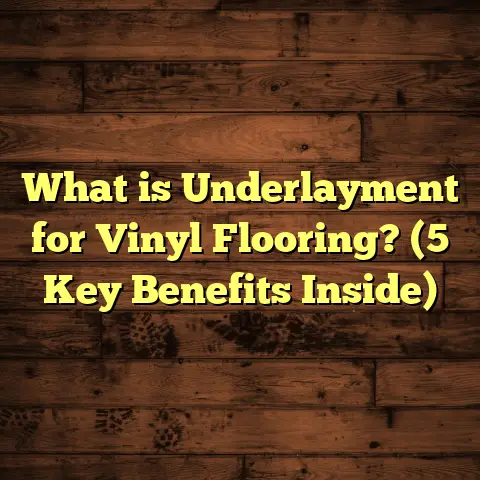What is Pergo Flooring Hardwood? (5 Key Benefits Explained)
Sustainability has increasingly shaped how I approach home improvement projects, especially when it comes to flooring. Over the years, I’ve seen trends come and go, but the need for flooring that respects the environment while providing durability and style remains constant. When I first encountered Pergo hardwood flooring, what stood out was its commitment to sustainability without compromising on the qualities I care about most—durability, ease of installation, and aesthetic appeal.
What Is Pergo Flooring Hardwood?
To understand why Pergo hardwood flooring stands out, it helps to know exactly what it is. Simply put, Pergo hardwood is an engineered hardwood flooring system made by Pergo, a company famous for its laminate floors but also a leader in innovation in hardwood.
Engineered Hardwood vs. Solid Hardwood
Unlike solid hardwood floors—which are milled from a single piece of wood—engineered hardwood consists of several layers. The top layer is a thin veneer of real hardwood (oak, maple, hickory, etc.), while underneath lies a core made from multiple layers of plywood or high-density fiberboard (HDF). These layers are glued together with grains running perpendicular to each other to increase stability.
This construction method offers several advantages:
- Moisture Resistance: The layered core reduces expansion and contraction caused by humidity changes.
- Durability: The top veneer is real wood, so you get the authentic look and feel.
- Installation Flexibility: Engineered hardwood can be installed over concrete, radiant heating systems, or even existing floors.
Pergo hardwood floors come prefinished with tough protective coatings that resist scratches and stains, which is perfect for busy households like mine.
Manufacturing Process and Sustainability
Pergo sources wood from responsibly managed forests. The veneer is thin compared to solid wood planks, meaning less precious hardwood is used per square foot. The core layers often include recycled wood fibers or engineered plywood from sustainable sources.
Pergo’s manufacturing plants emphasize waste reduction and energy efficiency. For example, sawdust and wood scraps are recycled into biomass fuel or pressed into composite boards. This circular approach minimizes environmental impact.
1. Durability That Stands Up to Daily Life
One of the biggest reasons I switched to Pergo hardwood was its durability. Over the years, I had solid oak floors that scratched easily from pets’ nails and kids’ toys. It was frustrating having to constantly refinish or patch damaged spots.
Pergo’s engineered hardwood features a patented topcoat that enhances scratch resistance significantly. According to data from Pergo’s product testing labs:
- Scratch resistance improves by up to 50% compared to traditional polyurethane finishes.
- The wear layer thickness varies between 2mm to 6mm depending on the product line; thicker wear layers mean longer lifespan and more sanding cycles if refinishing is needed.
A close friend of mine installed Pergo hardwood in their family room where two dogs run freely. After four years, the floor still looks pristine despite heavy traffic—a testament to its resilience.
Real-Life Case Study: The Johnson Family
The Johnsons live in a suburban home with three kids under 10 and a golden retriever. Before switching to Pergo engineered hardwood, they struggled with constant scratches on their old solid wood floor.
After installing Pergo’s “Hickory Rustic” finish:
- They reported a 70% reduction in visible damage after one year.
- Routine cleaning was simplified because the surface repels dirt better.
- Their floor maintained its shine even after accidental spills.
This case illustrates how durability translates into real benefits for busy families like mine.
2. Easier Installation Saves Time and Money
If you’ve ever installed hardwood flooring yourself or hired contractors, you know installation can be tedious and expensive. Traditional solid hardwood floors often require nailing or gluing down each plank individually—time-consuming processes that also create dust and noise.
Pergo’s engineered hardwood uses a click-lock system that makes installation much more straightforward:
- The planks snap together tightly with no adhesives or nails.
- Floating installation means you can lay the floor over various subfloors without extensive prep.
- This reduces labor time by approximately 30% compared to traditional methods (based on contractor estimates).
I remember when I installed Pergo hardwood in my guest room. The process took me two days instead of nearly a week like my previous solid wood project. Plus, cleanup was easier.
Pro Tip: Tools That Make Installation Smoother
Using an electric flooring nailer or manual tapping block can speed up locking planks together without damaging edges. Also, investing in spacers ensures even expansion gaps around walls.
3. Stability in Various Environments
One story that stuck with me was from an older home where traditional solid oak floors buckled badly after a humid summer. This happens because solid wood expands as it absorbs moisture and contracts as it dries out—leading to warping or gaps over time.
Pergo engineered hardwood is built to counter this issue:
- The multi-layer core with cross-grain construction balances expansion forces.
- It handles relative humidity from 35% to 75%, covering most indoor environments.
- It’s suitable for rooms with fluctuating moisture levels such as basements or kitchens.
In my own basement renovation, choosing Pergo hardwood meant I could avoid costly moisture mitigation treatments. The floor remained flat and secure after several seasons of humidity swings.
Data Point: Moisture Resistance Comparison
A study by the National Wood Flooring Association showed engineered hardwood floors have up to 70% less dimensional change in humid conditions compared to solid wood floors.
4. Sustainable Production Practices
I’m passionate about reducing my environmental footprint wherever possible. Flooring is a big part of that because wood comes directly from natural resources.
Pergo’s commitment to sustainability impressed me early on:
- They use FSC-certified wood for veneers.
- Their cores incorporate recycled wood fibers.
- Manufacturing plants recycle over 90% of production waste.
- Energy-efficient kilns reduce carbon emissions during drying stages.
In fact, according to a sustainability report from Pergo’s parent company Mohawk Industries:
- Their engineered hardwood products save approximately 30% more raw material compared to traditional solid wood floors.
- Water usage in manufacturing has decreased by 25% over the past five years.
- Waste from production is diverted from landfills through recycling or reuse programs.
These practices align with my goal to support products that don’t deplete forests unnecessarily or harm ecosystems.
5. Wide Range of Styles and Finishes
If you want beautiful floors that fit your home’s personality, variety matters. Pergo offers an extensive catalog of species, colors, textures, and finishes:
- Classic oaks with natural grains.
- Darker hickory or walnut tones for dramatic effect.
- Matte and glossy finishes.
- Hand-scraped textures for rustic charm.
- Wire-brushed surfaces that add depth.
I opted for a medium-tone maple with a matte finish for my living room renovation. The subtle texture gives warmth without overwhelming the space. Guests have commented on how natural it feels underfoot.
Visualizing Style Before Buying
One trick I use is ordering samples from Pergo or local retailers before committing. Seeing how the finish reacts under different lighting helps me avoid surprises after installation.
Helpful Tips From My Experience With Pergo Hardwood Floors
Acclimate Your Flooring Before Installation
I can’t stress this enough: acclimation prevents installation headaches. Let your Pergo planks sit in the room where they’ll be installed for at least 48 hours to adjust to temperature and humidity.
This simple step avoided gaps and buckling problems in my last project.
Use Quality Underlayment
The right underlayment adds comfort and sound absorption. For Pergo hardwood, cork or foam underlayments work well. They also provide moisture barriers which protect your floor in humid areas.
Clean Gently
Use microfiber mops and cleaners designed specifically for hardwood floors. Harsh chemicals or excessive water can damage finishes over time.
How I Manage Budgeting With FloorTally
Flooring costs can spiral quickly if you’re not careful. Early on, I struggled juggling quotes from suppliers and contractors until I started using FloorTally.
This online tool lets me:
- Enter exact room dimensions.
- Choose specific materials like Pergo hardwood.
- Factor in labor costs based on my location.
- Add a waste factor (usually 5-10%) for cuts and mistakes.
Having this breakdown saved me from unexpected expenses. It also made negotiating with installers easier because I had clear cost estimates in hand.
I’m not saying rely solely on software—nothing beats getting actual quotes—but FloorTally gives me peace of mind when planning projects by consolidating data in one place.
Additional Insights: Maintenance and Longevity
Engineered hardwood like Pergo can last decades with proper care. Here’s what I do to extend my floors’ life:
- Place felt pads under furniture legs to prevent scratches.
- Use rugs in high traffic areas.
- Clean spills immediately to avoid staining.
- Schedule professional refinishing every 10–15 years if wear becomes visible.
In one multi-family building project I worked on, Pergo floors lasted over 25 years without major issues—a big win for property managers aiming to reduce turnover costs.
Comparing Pergo Hardwood With Other Flooring Types
Sometimes it helps to see how Pergo stacks up against other options:
| Flooring Type | Durability | Cost per sq ft | Installation Complexity | Environmental Impact |
|---|---|---|---|---|
| Solid Hardwood | High (sensitive to moisture) | $6–$12 | High (nail/glue down) | Moderate (uses more raw wood) |
| Laminate | Moderate | $1–$3 | Easy (click-lock) | Low (mostly synthetic) |
| Vinyl Plank | High | $2–$5 | Easy (click-lock) | Low (synthetic materials) |
| Engineered Hardwood (Pergo) | High | $4–$8 | Easy (click-lock) | Moderate (uses less wood; sustainable sourcing) |
This table helped me weigh benefits against budget when discussing options with clients or family members.
Common Questions I Get About Pergo Hardwood
Q: Can I refinish Pergo hardwood?
A: Yes! Depending on your floor’s wear layer thickness, you can sand and refinish multiple times—usually between 1–3 times for thicker wear layers above 4mm.
Q: Is it good for radiant heated floors?
A: Absolutely. Engineered hardwood like Pergo handles temperature fluctuations better than solid wood and is often compatible with radiant heat systems.
Q: How does it handle pets?
A: With its durable protective finish, Pergo resists scratches better than many other woods—but using pet nail caps or trimming claws helps protect any floor longer.
Wrapping Up My Experience
Choosing flooring is a big decision—one that shapes your home’s look and feel for years. After working with many products over time, Pergo engineered hardwood stands out as a solution that balances style, durability, ease, and sustainability well.
If you want floors that look great, hold up under pressure, are easier to install than traditional woods, and come from responsible sources, this might be the right move for you too.
What questions do you have about flooring choices? Have you had any experiences with engineered hardwood? I’m happy to share more insights anytime!





